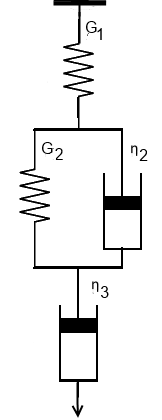Burgers Viscoelasticity
Quick Start
The full G'/G'' viscoelastic performance across the whole temperature/time range can be nicely demonstrated via this idealised Burgers model kindly provided by Roelof Luth1.
Burgers Viscoelasticity
 The Burgers model involves two springs G1 and G2, with two dashpots, η2 and η3. The nice thing about the model, when viewing the whole range of viscoelastic behaviour from rigid polymer to weak liquid, is that the 4 parameters work rather independently. So we can say that:
The Burgers model involves two springs G1 and G2, with two dashpots, η2 and η3. The nice thing about the model, when viewing the whole range of viscoelastic behaviour from rigid polymer to weak liquid, is that the 4 parameters work rather independently. So we can say that:
- G1 is simply the bulk modulus of the polymer below its Tg
- G2 is simply the plateau modulus of a polymer in its rubbery phase.
- η2 defines the Tg
- η3 defines the approach towards the melted material.
The model automatically gives us some extra important values (we already have G'p, the plateau modulus as this is G2), given that temperature and time are conveniently interconvertable in this idealised model:
- Tanδmax. The maximum value of Tanδ
- tδmax. The timescale (i.e. 1/ω) at which it Tanδmax occurs
- Tδmax. The temperature at which it Tanδmax occurs
- tcross. The timescale at which G' and G'' cross, signifying the end of the plateau region.
- Tcross. The temperature of the crossing point.
1The app originated in a discussion over a beer in a sunny square near Amsterdam. Luth is an expert rheologist and I am not. It took a lot of patience from Luth (and some expert algebra) before I could write a functioning app. The app was originally written for the specific area of PSA (see the Ideal PSA app) and has been astonishingly useful in that area. I record my formal thanks for his ideas and assistance.

